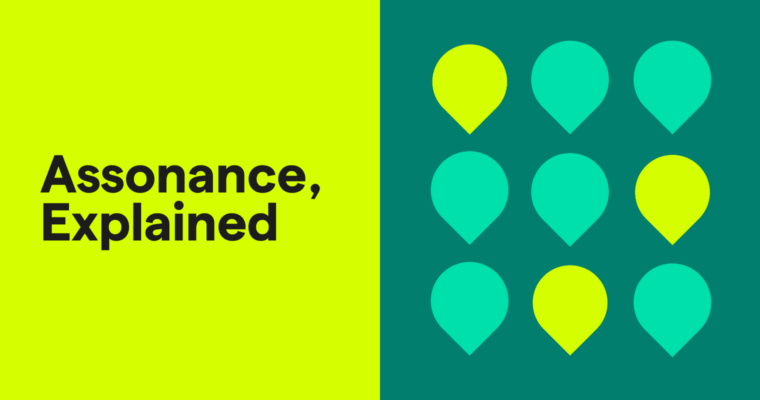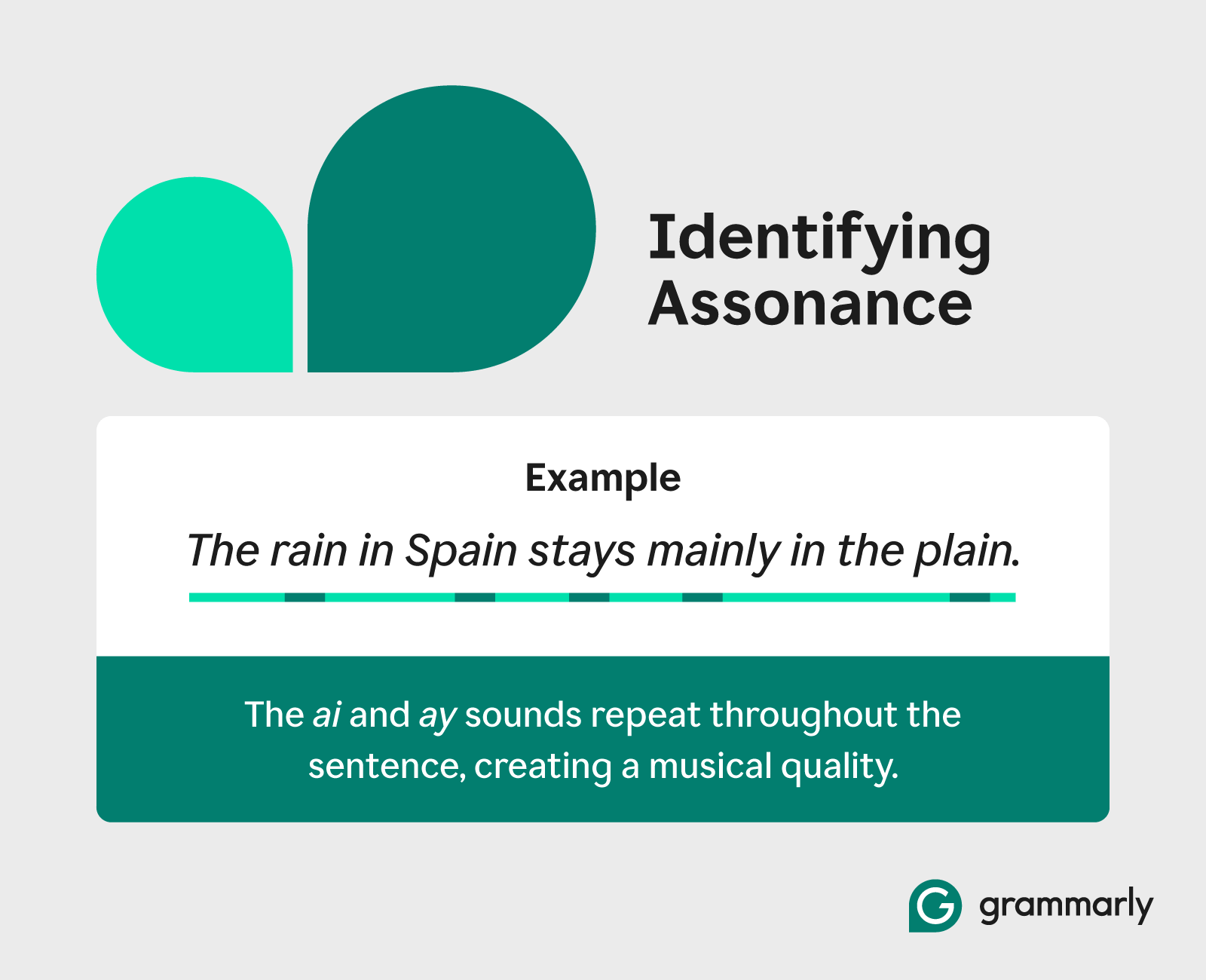
Key takeaways:
- Assonance is a literary device where vowel sounds are repeated in nearby words, creating a smooth, musical flow.
- Assonance is commonly used in poetry, song lyrics, and speeches to make phrases more memorable.
- An example of assonance is “Tryin’ to reach my goal, my power of speech unimpeachable,” where the long ee sound is repeated.
Ever notice how certain phrases just sing? That’s often due to assonance, a literary device where vowel sounds echo across nearby words, creating that internal musicality.
Unlike rhymes, which create their rhythm by repeating both the vowel and ending consonant sounds of words, assonance focuses specifically on repeated vowel sounds within words. This subtle repetition appeals to our natural love of sound and rhythm, giving phrases a smoother, more pleasing flow.
In this post, we’ll explore how assonance works, highlight famous examples, and show you how to incorporate it into your writing to create a greater impact.
Table of contents
How assonance enhances your writing
Assonance vs. other literary devices
Defining assonance
Assonance is when vowel sounds repeat in nearby words, especially in the middle of words or in stressed syllables. You’ll often hear assonance in poetry and song lyrics, but it works just as well in everyday writing.
One of the most famous examples is “The rain in Spain stays mainly in the plain.”

In this sentence, the long a sound repeats in rain, Spain, stays, mainly, and plain. That repetition gives the line a musical, catchy feel, without the words needing to rhyme exactly.
Writers and speakers often use assonance to create a smooth rhythm or to highlight certain phrases. It’s all about how vowel sounds work together.
How assonance enhances your writing
Repeating vowel sounds can create rhythm, set the mood, and make certain words stand out. So, whether you’re writing a poem or just want your sentences to flow better, here’s how assonance can help:
1 Create rhythm
Assonance can make writing sound more musical, especially in poems or lyrics. It’s like rhyming, but a little more subtle.
2 Set the mood
Different vowel sounds can create different feelings. Long oo sounds (as in “moon”) can feel calm or eerie, while short i sounds (as in “pin”) might sound sharp or tense.
3 Highlight important words
Repeating a vowel sound can make certain words stand out and stick with the reader.
4 Make prose more poetic
Even in regular writing, assonance can make sentences sound more polished or powerful. Just don’t overdo it, as too much can feel forced.
Assonance examples
Below are several examples of assonance in everyday phrases, songs, and literature, with the repeated vowel sounds bolded. While these examples focus on key instances of assonance, you may also notice other subtle repetitions of vowel sounds throughout the phrases and excerpts.
| Example | Format | Explanation |
| “Train hard, play smart.” | Common phrase | Features the repeated long “ay” sound, reinforcing the connection between effort and reward. |
| “Keep your eyes on the prize.” | Common phrase | Showcases the repeated long “eye” sound (as in “buy”), adding rhythm and emphasizing focus and determination. |
|
“Good day in my mind, safe to take a step out Get some air now, let your edge out.” —SZA, “Good Days” |
Song | Highlights the repeated long “ay” sound (as in “say”), creating a calming flow that aligns with the theme of reflection. |
|
“Tryin’ to reach my goal, my power of speech unimpeachable Only nineteen, but my mind is older These New York City streets get colder, I shoulder Ev’ry burden, ev’ry disadvantage.” —“My Shot,” from Hamilton |
Song | Emphasizes the repeated long “ee” sound (as in “see”), underlining resilience and determination. |
|
“Soft language issued from their spitless lips as they swished in low circles round and round the field, winding hither and thither through the weeds.” —James Joyce, A Portrait of the Artist as a Young Man |
Literature | Demonstrates the repeated short “ih” sound (as in “bit”), evoking smooth, flowing motion in the scene. |
|
“… about the glade in a frail agony of grace, she trailed her rags through dust and ashes.” —Cormac McCarthy, Outer Dark |
Literature | Illustrates the repeated long “ay” sound (as in “say”), highlighting the sorrowful tone of the scene. |
|
“The mailman still hands me bills like I should be lucky.” —Hanif Abdurraqib, “Watching a Fight at the New Haven Dog Park, First Two Dogs, and Then Their Owners” |
Poetry | Features the repeated short “ih” vowel sound (as in “bit”), adding a cynical tone to the frustration. |
|
“A bat cracks in the flickering background, and we’re dead tired from the horse track.” —Ada Limón, “The Good Wave” |
Poetry | Showcases the repeated short “a” sound (as in “cat”), emphasizing fatigue and weariness. |
Assonance vs. other literary devices
Writers often use sound-based techniques to create rhythm, emphasis, or mood. While assonance is one of the most common, it’s helpful to understand how it differs from similar devices like alliteration, consonance, and anaphora.
| Literary device | Definition | Example | How does it differ from assonance |
| Alliteration | Repeating the same consonant sound at the start of words | She sells seashells by the seashore. | Focuses on initial consonant sounds, while assonance repeats vowel sounds within words |
| Anaphora | Repeating a word or phrase at the start of lines or clauses | Every day, every night, in every way, I am getting better and better. | Repeats entire words or phrases, not just vowel sounds |
| Consonance | Repeating consonant sounds within or at the end of words | Pitter patter, splish splash. | Involves consonant sounds, whereas assonance focuses on vowel sounds. |
Craft memorable writing with assonance
Assonance creates a subtle musicality that keeps readers engaged and helps your message resonate. Using assonance in your writing can enhance the emotional impact and create more memorable content.
Improve your sentence structure with Grammarly
Looking to elevate your writing? Grammarly helps you catch structural issues and improve clarity with tailored suggestions. Use it to make sure your use of assonance stays clear, effective, and grammatically correct.
Assonance FAQs
Below are frequently asked questions about assonance and its uses to help you understand how this literary device works in writing and beyond.
What written formats best suit assonance?
Assonance works best in writing where sound and rhythm matter. It’s especially effective in:
- Poems: It helps create a musical feel and flow.
- Song lyrics: It makes songs sound catchy and emphasizes feelings.
- Speeches: It can make important phrases easier to remember.
- Stories: Writers can use it subtly to make descriptions smoother or highlight certain words.
- Advertisements and slogans: Assonance makes them more memorable.
How can assonance be used as a mnemonic device to help with memorization?
Assonance can strengthen memory by adding rhythm and repetition, making phrases stick in the mind more easily. A well-known example of assonance used as a mnemonic is the phrase “Look left, look right, look left again.” The repeated o sound in look creates a rhythmic pattern that helps people remember the step of checking traffic before crossing the street.
To use assonance as a mnemonic tool, try these tips:
- Use similar vowel sounds in important words to create a strong sound pattern.
- Keep phrases short and easy to say so they’re easier to remember.
- Focus on repeating sounds at key moments to emphasize the most important ideas.
- Use common word patterns to make phrases feel familiar.
- Say the phrase out loud to help it stick in your memory.
Are there any assonance synonyms?
The closest synonym for assonance is sound repetition, particularly in literary contexts. Other words with related meanings include:
- Consonance: Repeating consonant sounds in nearby words
- Alliteration: Repeating consonant sounds, usually at the beginning of words
- Rhyme: Words that share similar sounds, usually at the end
- Repetition: Using the same sounds or words more than once for emphasis
- Harmony: A pleasing arrangement of sounds, often in music or poetry






